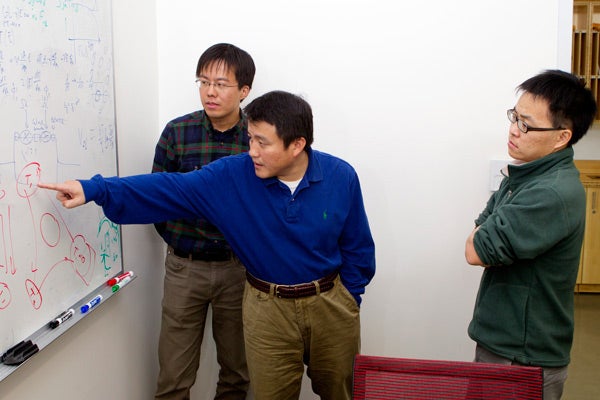|
November 1, 2012
Taming mavericks: Stanford researchers use synthetic magnetism to control light
Stanford researchers in physics and engineering have demonstrated a device that produces a synthetic magnetism to exert virtual force on photons similar to the effect of magnets on electrons. The advance could yield a new class of nanoscale applications that use light instead of electricity. By Andrew Myers

Professor Shanhui Fan (center), postdoc Zongfu Yu (right) and doctoral candidate Kejie Fang (left) have used synthetic magnetism to control the flow of light at the nanoscale. (Photo: Norbert von der Groeben)
Magnetically speaking, photons are the mavericks of the engineering world. Lacking electrical charge, they are free to run even in the most intense magnetic fields. But all that may soon change. In a paper published in Nature Photonics, an interdisciplinary team of Stanford physicists and engineers reports that they have created a device that tames the flow of photons with synthetic magnetism.
The process breaks a key law of physics known as the time-reversal symmetry of light and could yield an entirely new class of devices that use light instead of electricity for applications ranging from scientific devices such as accelerators and microscopes to speedier on-chip communications.
"This is a fundamentally new way to manipulate light flow. It presents a richness of photon control not seen before," said Shanhui Fan, a professor of electrical engineering at Stanford and senior author of the study.
A departure
The ability to use magnetic fields to redirect electrons is a founding principle of electronics, but a corollary for photons has not previously existed. When an electron approaches a magnetic field, it meets resistance and opts to follow the path of least effort, traveling in circular motion around the field. Similarly, this new device sends photons in a circular motion around the synthetic magnetic field.
The Stanford solution capitalizes on recent research into photonic crystals – materials that can confine and release photons. To fashion their device, the team members created a grid of tiny cavities etched in silicon, forming the photonic crystal. By precisely applying electric current to the grid they can control – or "harmonically tune," as the researchers say – the photonic crystal to synthesize magnetism and exert virtual force upon photons. The researchers refer to the synthetic magnetism as an effective magnetic field.
The researchers reported that they were able to alter the radius of a photon's trajectory by varying the electrical current applied to the photonic crystal and by manipulating the speed of the photons as they enter the system. Providing a great degree of precision control over the photons' path, this dual mechanism allows the researchers to steer the light wherever they like.
Broken laws
In fashioning the device, the team has broken what is known in physics as the time-reversal symmetry of light. Breaking time-reversal symmetry in essence introduces a charge on the photons that reacts to the effective magnetic field the way an electron would to a real magnetic field.
For engineers, it means that a photon traveling forward will have different properties than when it is traveling backward, the researchers said, and this yields promising technical possibilities. "The breaking of time-reversal symmetry is crucial as it opens up novel ways to control light. We can, for instance, completely prevent light from traveling backward to eliminate reflection," said Fan.
The new device, therefore, solves at least one major drawback of current photonic systems that use fiber optic cables. Photons tend to reverse course in such systems, causing a form of reflective noise known as backscatter.
"Despite their smooth appearance, glass fibers are, photonically speaking, quite rough. This causes a certain amount of backscatter, which degrades performance," said Kejie Fang, a doctoral candidate in physics at Stanford and the first author of the study.
In essence, once a photon enters the new device it cannot go back. This quality, the researchers believe, will be key to future applications of the technology, as it eliminates disorders such as signal loss common to fiber optics and other light-control mechanisms.
"Our system is a clear direction toward demonstrating on-chip applications of a new type of light-based communication device that solves a number of existing challenges," said Zongfu Yu, a postdoctoral researcher in Fan's lab and co-author of the paper. "We're excited to see where it leads."
Andrew Myers is associate director of communications at the School of Engineering.
-30-
|